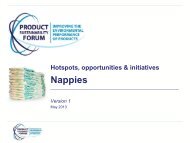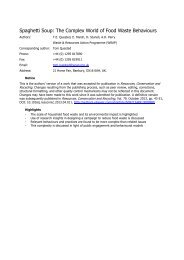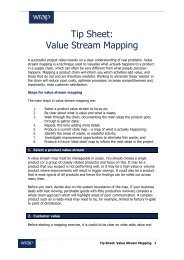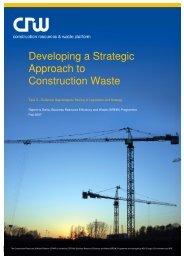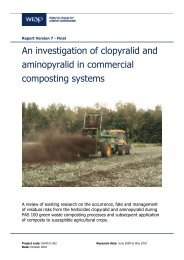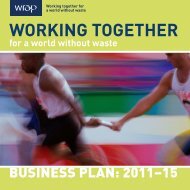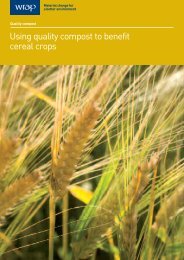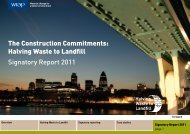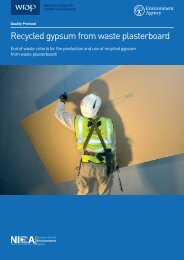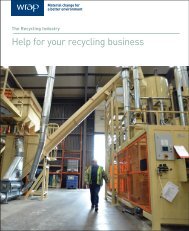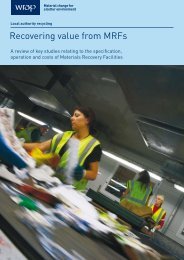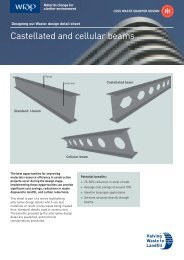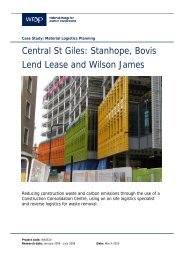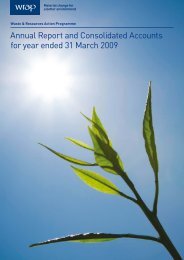Good Practice Guide - WRAP Northern Ireland
Good Practice Guide - WRAP Northern Ireland
Good Practice Guide - WRAP Northern Ireland
Create successful ePaper yourself
Turn your PDF publications into a flip-book with our unique Google optimized e-Paper software.
Materials Resource Efficiency in Street Works<br />
Materials Resource Efficiency in Street Works<br />
Utility <strong>Good</strong> <strong>Practice</strong> Industry <strong>Guide</strong>Agreement
Materials Resource Efficiency in Street Works<br />
<strong>Good</strong> <strong>Practice</strong> <strong>Guide</strong><br />
This good practice guide forms part of the<br />
suite of documents aimed at:<br />
■ increasing the use of recycled and<br />
stabilised materials in street works; and<br />
■ reducing the waste arisings sent to landfill<br />
(including the adoption of waste avoidance<br />
techniques such as trenchless technology<br />
and first time permanent reinstatement).<br />
This guide is designed to provide the<br />
Street Works Community (Utility Companies,<br />
their Contractors, Local Authority Inspectors,<br />
and Materials Suppliers) and other interested<br />
parties with an overview of the use of recycled<br />
and stabilised materials in street works, and<br />
the techniques associated with waste avoidance.<br />
In addition, the guide contains signposts to<br />
information and case studies that demonstrate<br />
what is feasible and achievable when using<br />
technologies to avoid waste generation, and in<br />
the use of recycled and stabilised materials.<br />
This guide does not aim to reproduce or replicate<br />
the UK Highways Authority and Utility Committee<br />
– HAUC (UK) – Specification for the Reinstatement<br />
of Openings in Highways, which is freely available<br />
from the DfT website 1 . The Specification should<br />
be used as the single source of information on<br />
the specification of materials in street works.<br />
Background to the <strong>Good</strong> <strong>Practice</strong> <strong>Guide</strong><br />
In 2005, it was estimated that the utilities<br />
sector generates about 4.8 million tonnes of<br />
trench excavation waste and about 2.5 million<br />
tonnes of this was landfilled 2 , enough to fill the<br />
Millennium Stadium. Not generating waste and<br />
recycling waste arisings, can deliver savings by<br />
avoiding new materials and waste disposal costs.<br />
The Draft Strategy for Sustainable Construction<br />
(England and Wales) suggests industry wide<br />
targets and milestones of:<br />
These targets for England and Wales are<br />
complemented by targets to:<br />
■ reuse or recycle 75% of construction,<br />
demolition and excavation wastes by 2020<br />
(<strong>Northern</strong> <strong>Ireland</strong> Waste Management<br />
Strategy 2006-2020); and<br />
■ reduce business waste, including<br />
construction and demolition waste,<br />
by 200,000 tonnes a year (Business Waste<br />
Framework - Scotland).<br />
Background Information<br />
In November 2005, <strong>WRAP</strong> commissioned<br />
research to investigate the use of trench<br />
arisings and other recycled materials in gas<br />
and water company trenches. The reserach 2<br />
estimated that arisings from water and gas<br />
companies’ asset renewal throughout<br />
Great Britain is 4.8 million tonnes per<br />
annum. The work also examined the<br />
barriers and opportunities for recycling<br />
trench arisings. To further define these<br />
barriers, and to develop an evidence base<br />
to address them, <strong>WRAP</strong> initiated two further<br />
projects in 2006/07.<br />
The first of these produced process and cost<br />
models for the two most prevalent practices<br />
for dealing with trench arisings, and<br />
compared these to recycling ‘hub’ options 3 .<br />
This demonstrated that a business case can<br />
be made for recycling hubs.<br />
The second project examined the technical<br />
aspects of using recycled and stabilised<br />
materials in reinstatements 4 . The project<br />
collated multiple case studies, highlighting<br />
that the second edition of the HAUC (UK)<br />
Specification 1 includes specific provision<br />
for the use of recycled aggregates and<br />
stabilised materials, including the reuse<br />
of trench arisings.<br />
Source: <strong>WRAP</strong><br />
By 2012<br />
By 2015<br />
By 2020<br />
A 50% reduction of<br />
construction, demolition<br />
and excavation waste sent<br />
to landfill, compared to 2005<br />
– also in the Waste Strategy<br />
for England 2007<br />
Zero net waste at construction<br />
site level<br />
Zero waste to landfill,<br />
where feasible<br />
Welsh HAUC – Approved materials<br />
Welsh HAUC have published tables of<br />
approved materials, including materials<br />
using recycled and secondary aggregates.<br />
The tables include approved materials<br />
containing blastfurnace slag and recycled<br />
asphalt.<br />
These materials, along with many others,<br />
are also allowed by the Highways Agency’s<br />
Specification for Highway Works.<br />
Source: Welsh HAUC website, www.welsh-hauc.org.uk<br />
1<br />
Specification for the Reinstatement of Openings in Highways, Highway Authority and Utilities Committee (UK), London, 2002. Available on line via www.dft.gov.uk<br />
2<br />
‘Identifying opportunities for recycling of excavated spoil from utility works in local authority areas, and promoting the use of recycled materials through<br />
good practice’, <strong>WRAP</strong>, 2005. Available on line via www.wrap.org.uk<br />
3<br />
‘Utilities Recycling Hub Commerciality Study’, <strong>WRAP</strong>, 2006. Available on line via www.wrap.org.uk<br />
4<br />
‘Recycled and stabilised materials in trench reinstatement’, <strong>WRAP</strong>, 2007. Available on line via www.wrap.org.uk
Materials Resource Efficiency in Street Works<br />
The Suite of Documents<br />
The Draft Strategy for Sustainable Construction 5<br />
is a joint industry/government strategy which<br />
includes the objective of developing agreements<br />
and initiatives between the construction<br />
industry and its clients with the aim of reducing<br />
the carbon footprint and use of resources.<br />
This guide supports voluntary agreements<br />
aiming to deliver a step change in the levels of<br />
recycled materials used and the waste landfilled<br />
by the utilities sector, shown in Figure 1.<br />
The suite of documents<br />
Utility<br />
Contractor<br />
Agreement<br />
Figure 1: Suite of utility industry voluntary agreements and<br />
supporting documents<br />
National Grid - Utility Company and<br />
Contractors partner to improve efficiency<br />
National Grid is committed to the protection<br />
and enhancement of the environment and,<br />
in 2005/6, two five-year Road to Zero targets<br />
were set:<br />
■ To reduce the amount of waste spoil that<br />
can be diverted from landfill to ZERO by<br />
2010/11<br />
■ To reduce the amount of primary<br />
aggregate used for reinstatement<br />
to ZERO by 2010/11 where suitable<br />
alternatives exist<br />
In 2004/5, approximately 300,000 tonnes of<br />
waste spoil was sent to landfill from gas mains<br />
replacement. This amounts to approximately<br />
58% of the total spoil excavated. Recognising<br />
the challenge, key performance indicators<br />
were set for the four Gas Alliance contracts,<br />
while term contractors were encouraged to<br />
recycle and use recycled materials.<br />
All ten contracting partners are now taking<br />
steps to ensure that waste is diverted<br />
to landfill and more recycled materials<br />
are used. Only 30% of waste spoil is now<br />
disposed of via landfill.<br />
Source: National Grid<br />
Utility<br />
Industry<br />
Agreement<br />
<strong>Good</strong> <strong>Practice</strong> <strong>Guide</strong><br />
Regional<br />
and HAUC/RAUC<br />
National<br />
HAUC/RAUC Memorandum<br />
Memorandum<br />
of Understanding<br />
of Understanding<br />
Councillor’s Briefing Note<br />
Local Authority Inspector's Briefing Note<br />
<br />
Database of Street Works Recycling<br />
<br />
<br />
Who Should Use this <strong>Guide</strong><br />
This guide should be used by Utility<br />
Contractors engaged in street works for the<br />
various Water, Telecommunication, Gas, or<br />
Electricity companies who have signed the<br />
Utility Industry Agreement. The Utility Industry<br />
Agreement commits its signatories to:<br />
■ writing company policies that embed:<br />
- the use of recycled and stabilised<br />
materials and<br />
- the reduction of waste arisings sent to<br />
landfill (including the adoption of waste<br />
avoidance techniques such as trenchless<br />
technology and first time permanent<br />
reinstatement);<br />
■ setting company targets and milestones for<br />
the increased use of recycled and stabilised<br />
materials and the reduction of the waste<br />
arisings sent to landfill;<br />
■ using procurement and contractual<br />
arrangements to deliver these company<br />
targets, where feasible;<br />
■ promoting the use of recycled and stabilised<br />
materials which meet specified performance<br />
and quality requirements 1 ; and<br />
■ pro-actively sharing knowledge<br />
on the use and trials of recycled and<br />
stabilised materials.<br />
To achieve their targets and milestones,<br />
the Utility Companies will need to work in<br />
partnership with their Contractors (and with<br />
Local Authorities and Materials Suppliers).<br />
In response to the commitment of the Utility<br />
Companies, Contractors are encouraged to<br />
sign up to the Utility Contactors Agreement,<br />
which includes similar commitments,<br />
including a commitment to:<br />
■ support Utility Companies by agreeing<br />
contractual targets and milestones to<br />
increase the use of recycled and stabilised<br />
materials, and reduce the waste arisings<br />
sent to landfill; and<br />
■ include targets and milestones for the use<br />
of recycled and stabilised materials and<br />
waste reduction in sub-contracts.<br />
A HAUC/RAUC Memorandum of Understanding<br />
has also been developed, which can be used<br />
to publicly demonstrate a Local Authority’s<br />
commitment to waste reduction and recycling<br />
in street works. This guide will also be of<br />
interest to Local Authority Inspectors looking<br />
for more information concerning the use of<br />
recycled materials in street works, or the use<br />
of waste avoidance technologies.<br />
5<br />
Draft Strategy for Sustainable Construction, Department for Business, Enterprise and Regulatory Reform (formerly the Department of Trade and Industry),<br />
London, July 2007. Available online via www.berr.gov.uk. This strategy is open for consultation until 30 November 2007
Materials Resource Efficiency in Street Works<br />
<strong>Good</strong> <strong>Practice</strong> Principles<br />
The waste hierarchy (Figure 2) is a well<br />
known and understood concept that should<br />
be considered for all trenching activities.<br />
This means that it is preferable to:<br />
■ reduce the quantities of waste generated<br />
(for example, by using trenchless<br />
technologies);<br />
■ reuse materials as they arise (for example,<br />
recycling trench arising at a local hub to be<br />
used in local trench reinstatements<br />
- closed loop recycling);<br />
■ use recycled materials for trench<br />
reinstatement rather than using primary<br />
materials (for example, using a recycled<br />
aggregate subbase in preference to a<br />
primary aggregate subbase);<br />
■ send excess materials for recycling rather<br />
than for landfill disposal; and<br />
■ only send materials unsuitable for recycling<br />
for landfill disposal.<br />
Waste avoidance techniques and closed loop<br />
recycling also:<br />
■ reduce the number of vehicle movements,<br />
which reduces the carbon emissions<br />
associated with reinstatement works;<br />
■ avoid unnecessary loading and unloading<br />
of materials, minimising congestion and<br />
easing traffic flow around the works; and<br />
■ reduce costs by avoiding the unnecessary<br />
disposal of waste materials and purchase<br />
of reinstatement materials.<br />
Reduce<br />
Reuse<br />
Recycle<br />
Dispose<br />
Figure 2: Schematic diagram showing the waste hierarchy<br />
<strong>WRAP</strong> – Economic viability of recycling<br />
hubs in London<br />
Process and cost models developed for<br />
<strong>WRAP</strong> demonstrated that investment in<br />
the land and equipment for a trench arising<br />
recycling hub can be economically viable.<br />
These models also indicate the true cost<br />
of waste disposal from street works.<br />
The process models indicate that the costs<br />
of establishing recycling hubs can be offset<br />
by reducing the costs of reinstatement by:<br />
1. 48% to recycle trench arisings through<br />
a waste transfer station and reinstate<br />
with primary aggregate<br />
2. Up to 56% to send trench arisings to<br />
a recycling hub and to reinstate with<br />
materials from the hub<br />
Compared to sending trench arisings<br />
to landfill and reinstating with primary<br />
material. All ten contracting partners are<br />
now taking steps to ensure that waste<br />
is diverted to landfill and more recycled<br />
materials are used. Only 30% of waste spoil<br />
is now disposed of via landfill.<br />
Source: ‘Utilities Recycling Commerciality Study’,<br />
www.wrap.ork.uk/construction<br />
Alfred M c Alpine and Encore Aggregates<br />
– Recycled trench arisings in<br />
reinstatement<br />
Alfred M c Alpine were involved with the<br />
reinstatement of trenches excavated to<br />
allow works to be undertaken on a gas<br />
pipeline at Clyde Street in Glasgow.<br />
The in situ material was excavated and<br />
recycled ex situ by Encore Aggregates.<br />
The material was then reused in the<br />
reinstatement works.<br />
Source: AggRegain website, www.aggregain.org.uk<br />
United Utilities - CBEM3 trials in Leeds<br />
The CBEM3 (cement-bound excavated<br />
material) pilot trial was set up by National<br />
Grid at Sheepscar, Leeds, in August 2004,<br />
and continues to operate successfully under<br />
United Utilities.<br />
The current trials of CBEM3 in West<br />
Yorkshire are intended to prove CBEM3 as<br />
a long-term, commercially and practically<br />
viable reinstatement solution for much<br />
larger workloads in a relatively small<br />
geographical area.<br />
Source: United Utilities<br />
5<br />
Draft Strategy for Sustainable Construction, Department for Business, Enterprise and Regulatory Reform (formerly the Department of Trade and Industry),<br />
London, July 2007. Available online via www.berr.gov.uk. This strategy is open for consultation until 30 November 2007
Materials Resource Efficiency in Street Works<br />
Thames Water & Clancy Docwra -<br />
Trenchless mains reinstatement<br />
in London<br />
As part of its Alliance Agreement with<br />
Thames Water, Clancy Docwra has laid<br />
300 km of mains, completing over 50% using<br />
trenchless techniques including directional<br />
drilling, pipe bursting and insertion.<br />
The high percentage of trenchless mains<br />
installation has been achieved by employing<br />
an innovative approach to the works and<br />
ensuring pre-construction planning is<br />
intense and detailed.<br />
Using expert utility apparatus locating<br />
services has resulting in an improved unit<br />
rate, improved relations with the various<br />
London Boroughs, and an excellent Health,<br />
Safety and Environmental record with<br />
minimal damages or accidents.<br />
Source: Source: Thames Water/Clancy Docwra<br />
National Grid - Keyhole Road<br />
Openings Utilising Core & Vacuum<br />
Excavation Techniques<br />
National Grid is the first utility in the UK to<br />
combine vacuum and coring technology for<br />
excavating in the Highway. This is a method<br />
of opening the highway to work on plant<br />
through either an 18 inch or 24 inch hole.<br />
The technique involves two main<br />
components:<br />
■ A core is cut into the surface down to<br />
the subbase; the complete core is then<br />
removed for refitting after the work<br />
■ A vacuum is used to remove all the soil<br />
down to the apparatus to be worked.<br />
Special tooling has also been developed<br />
so that work can be carried out from the<br />
surface through the 18 inch hole.<br />
The excavated material is then compacted<br />
to a compliant level, and finally, the core is<br />
bonded back into position.<br />
Source: National Grid<br />
WASTE AVOIDANCE<br />
Trenchless Technology<br />
According to the Society for Trenchless<br />
Technology (www.ukstt.org.uk) 6 , Trenchless<br />
Technologies are “Methods for utility and other<br />
line installation, rehabilitation, replacement,<br />
renovation, repair, inspection, location and leak<br />
detection, with minimum excavation from the<br />
ground surface”.<br />
The Society’s website provides a useful<br />
introduction to trenchless technologies,<br />
as does the Department for Transport’s best<br />
practice guidance 7 . In addition, the Highways<br />
Agency’s Design Manual for Roads and<br />
Bridges (DMRB) includes an advice note on<br />
trenchless technologies 8 . It should be noted<br />
that trenchless technologies are not always<br />
suitable and there may be no alternative to<br />
opening trenches.<br />
According to the UKSTT website, Trenchless<br />
Technology can be broken into three areas:<br />
■ repair and Renovation, Cleaning, Localised<br />
Repair Techniques and Lining;<br />
■ replacement, Pipebursting, Pipe Splitting,<br />
Pipe Eating and Lead Extraction &<br />
Replacement Systems; and<br />
■ rew installation. Impact Moling,<br />
Pipe Ramming, Auger Boring & Thrust<br />
Boring, Pipe Jacking, Micro Tunnelling,<br />
<strong>Guide</strong>d Rod Pushing, <strong>Guide</strong>d Boring &<br />
Directional Drilling, Rock Boring, Cable<br />
Pulling and Cable Blow In Systems.<br />
Keyhole Techniques<br />
For small excavations, keyhole techniques can<br />
be utilised to minimise the size of the opening,<br />
reducing disruption and the amount of arisings<br />
and, if the excavated material is used for<br />
reinstatement, reducing the amount of waste<br />
sent to landfill.<br />
First Time Permanent Reinstatement<br />
It is not uncommon for utility excavations to<br />
be initially reinstated on a temporary basis.<br />
At a later date the temporary reinstatement<br />
is replaced with a permanent one.<br />
This approach is inefficient as the temporary<br />
materials that are removed will either go to<br />
landfill or are taken to be recycled off site.<br />
Whenever possible, first time permanent<br />
reinstatement should be undertaken.<br />
This will result in less materials being wasted<br />
and may also reduce the costs associated with<br />
the reinstatement process.<br />
6<br />
Glossary – Trenchless Technology, United Kingdom Society for Trenchless Technology (UKSTT), Leamington Spa. Online at www.ukstt.org.uk/glossary<br />
7<br />
Best <strong>Practice</strong> In Street Works And Highway Works, Department for Environment, Transport and the Regions (now under the Department for Transport),<br />
London, 2001. Online via www.dft.gov.uk<br />
8<br />
Guidance On The Trenchless Installation Of Services Beneath Motorways And Trunk Roads – HA 120/07, Volume 4 - Geotechnics And Drainage, Section 1<br />
– Earthworks, Part 8, Highways Agency, London, 2007. Online via www.highways.gov.uk
Materials Resource Efficiency in Street Works<br />
RECYCLED AND STABILISED MATERIALS<br />
The <strong>WRAP</strong> guidance document - Recycled and<br />
stabilised materials in trench reinstatement 4 ,<br />
highlights good practice in recycling trench<br />
excavation wastes.<br />
Specific provision is given for the use of<br />
recycled aggregates and hydraulically<br />
bound mixtures, and the reuse of trench<br />
arisings, within the second edition of the<br />
Specification for the Reinstatement of<br />
Openings in Highways 1 . This has recently<br />
been complemented by Advice Note 1,<br />
which has been produced “to clarify various<br />
issues associated with Appendix A9” of the<br />
Specification and thereby removes barriers to<br />
the use of stabilised materials.<br />
Wide experience with recycled materials and<br />
stabilised materials (hydraulically bound<br />
mixtures) already exists, both within the utility<br />
reinstatement sector and the wider highway<br />
engineering community. Taken from the <strong>WRAP</strong><br />
guidance document, Figure 3 shows materials<br />
flows in good practice recycling 4 .<br />
Recycled Materials<br />
Recycled materials in reinstatements are<br />
permitted by the HAUC (UK) Specification for<br />
the Reinstatement of Openings in Highways;<br />
as they are specified in the Highways Agency’s<br />
Specification for Highway Works 9 .<br />
The Specification for Highway Works includes<br />
the use of recycled aggregates (from<br />
construction, demolition and excavation waste)<br />
and secondary aggregates (by-products of<br />
industrial processes) in capping, subbase,<br />
base, binder and surface course layers.<br />
This includes their use in concrete, asphalt<br />
(including foamed asphalt), and hydraulically<br />
bound and unbound mixtures (such as<br />
subbases and cappings) 9 .<br />
Transportation of<br />
trench arisings<br />
Landfill<br />
<strong>WRAP</strong> AggRegain Specifier Tool<br />
The <strong>WRAP</strong> AggRegain Specifier tool,<br />
online at www.aggregain.org.uk, is a free<br />
tool that helps specifiers and buyers<br />
choose the right aggregate for the right<br />
application, to see which recycled and<br />
secondary aggregates can be used in the<br />
chosen application. Users can download<br />
detailed technical notes and case studies<br />
demonstrating the use of recycled<br />
materials.<br />
For example, searching via unbound<br />
subbase indicates that Type 1, 2, 3 and R<br />
subbase can use a wide range of recycled<br />
and secondary aggregates:<br />
■ Blastfurnace & Zinc slag<br />
■ Burnt Colliery spoil<br />
■ China clay sand and Stent<br />
■ Foundry sand<br />
■ Incinerator bottom ash<br />
■ Recycled aggregate (RA)<br />
■ Recycled asphalt (up to 50%)<br />
■ Recycled concrete aggregate (RCA)<br />
■ Recycled glass<br />
■ Slate aggregate<br />
■ Spent oil shale<br />
■ Steel slag<br />
Barhale Construction – ‘Trenchmod’<br />
in the Borough of Camden<br />
Barhale Construction used ‘Trenchmod’ –<br />
a proprietary system for recycling materials<br />
– on a project in Mansfield Road, Camden,<br />
to modify the trench arisings for future<br />
reinstatements. Arisings were taken to the<br />
‘Trenchmod’ plant located on a Thames<br />
Water site at Lea Bridge, Hackney.<br />
The processed material was then<br />
transported back to Camden as and<br />
when required.<br />
Trench excavation<br />
& reinstatement<br />
Local<br />
transportation of<br />
trench arisings<br />
On-site re-use or<br />
recycle (quality<br />
controlled process)<br />
Recycling (quality<br />
conrolled process)<br />
Non<br />
recyclable<br />
waste<br />
Other<br />
application<br />
The performance history of the product and<br />
previous Utility Companies’ usage has led<br />
to an outright conditional acceptance from<br />
the London Borough of Camden, where<br />
‘Trenchmod’ may be used as a backfill/Type<br />
1 subbase alternative.<br />
Local<br />
transportation<br />
of certified<br />
reinstatement<br />
materials<br />
Source: ‘Recycled and Stabilised Materials in Trench<br />
Transportation<br />
of primary<br />
reinstatement<br />
materials<br />
Other<br />
feedstock<br />
KEY<br />
<strong>Good</strong> practice<br />
Standard practice<br />
Figure 3: Simplified materials flow highlighting good<br />
practice 4<br />
9<br />
Specification for Highway Works, Volume 1, Manual of Contract Documents for Highway Works, Highways Agency, London. Online via www.highways.gov.uk
Materials Resource Efficiency in Street Works<br />
Stabilised Materials<br />
The HAUC (UK) Specification for the<br />
Reinstatement of Openings in Highways 1<br />
allows the use of stabilised materials, such<br />
as hydraulically bound mixtures (HBMs),<br />
where there is evidence that the material will<br />
meet specified technical and performance<br />
requirements.<br />
Stabilised materials are attractive in many<br />
highway and other construction projects as<br />
they can improve locally available otherwise<br />
unsuitable materials, suitable to use and fit<br />
for purpose. The use of stabilised materials<br />
can enable trench arisings to be recycled,<br />
avoiding waste, transportation and disposal,<br />
and bringing primary materials to site.<br />
Advice Note 1 confirms that:<br />
■ materials complying with to Series 800<br />
of the Highways Agency’s Specification<br />
for Highway Works 9 can be used without<br />
trial. Series 800 includes specifications for<br />
stabilised materials (HBMs) in subbase<br />
and base layers; and<br />
■ when a stabilised material has gained<br />
approval from one Authority (and the<br />
results and audit trail are available), other<br />
Authorities cannot withhold permission to<br />
use the material unless there are reasonable<br />
engineering reasons for doing so.<br />
HBM<br />
CBGM A<br />
CBGM B<br />
CBGM C<br />
FABM 1<br />
FABM 2<br />
FABM 3<br />
FABM 5<br />
SBM B1-2<br />
SBM B2<br />
SBM B3<br />
HRBBM 1<br />
HRBBM 2<br />
HRBBM 3<br />
SC<br />
SFA<br />
SHRB<br />
SS<br />
General<br />
Description<br />
Cement Bound<br />
Granular<br />
Mixtures<br />
Fly Ash Bound<br />
Mixtures<br />
Slag Bound<br />
Miixtures<br />
Hydraulic Road<br />
Binder Bound<br />
Mixtures<br />
Treated Soils 840<br />
Series 800<br />
Clauses<br />
821-823<br />
830-832, 834<br />
830-832<br />
830-832<br />
Morrison Utility Services -<br />
Stabilised trench arisings in<br />
Type 2 roads in Hampshire<br />
Morrison Utility Services conducted an<br />
approval trial using SMR Soil Stabiliser to<br />
recycle trench arisings into a Type 2 road in<br />
Sarisbury Green, Hampshire.<br />
The excavated trench arisings were<br />
processed at a nearby site and the SMR<br />
stabilised material transported back to<br />
the site when required. The SMR Soil<br />
Stabiliser is suitable for both large and<br />
small reinstatement operations as it can be<br />
incorporated using mobile plant and hand<br />
mixing. Testing of this material has shown<br />
that it can outperform SHW Type 1 subbase.<br />
Following the successful trial on the A27,<br />
the material has now been approved for<br />
Type 2, 3, and 4 roads across Hampshire.<br />
Source: ‘Recycled and stabilised materials in trench<br />
reinstatement’, www.wrap.org.uk/construction<br />
O’Keefe – Assessment of lime<br />
treated arisings<br />
A site trial of lime modified material was<br />
carried out at the O’Keefe Construction<br />
plant yard in Dunbrick, Sevenoaks. The<br />
material, provided by Skanska, was<br />
screened to remove the fraction >40 mm.<br />
The remaining material was divided,<br />
with half being treated with the addition<br />
of 1% lime.<br />
Both materials were then used to reinstate<br />
a small trench, where two CBR tests were<br />
carried out. Two weeks later further CBR<br />
test readings were taken.<br />
CBR (%)<br />
80<br />
60<br />
40<br />
20<br />
0<br />
untreated<br />
– tested<br />
immediately<br />
untreated<br />
at 2 weeks<br />
age<br />
1% lime at 2<br />
weeks age<br />
The results showed no improvement in<br />
strength for the untreated material, whereas<br />
the treated material showed significant<br />
strength gain.<br />
Source: O’Keefe Soil Remediation<br />
2% lime at 2<br />
weeks age<br />
insitu test -<br />
immediate<br />
insitu test<br />
at 2 weeks<br />
age
Materials Resource Efficiency in Street Works<br />
This guide was developed by:<br />
This agreement was developed by:<br />
HAUC CSS NJUG<br />
This agreement was developed by:<br />
This agreement was developed by:<br />
HAUC CSS NJUG<br />
HAUC CSS NJUG<br />
Front cover photograph: Volumetric truck used to batch recycled material for the manufacture of HBM,<br />
photograph<br />
Front<br />
courtesy<br />
cover photograph:<br />
of Clancy Docwra.<br />
Volumetric truck used to batch recycled material for the manufacture of HBM,<br />
photograph courtesy of Clancy Docwra.<br />
Front cover photograph: Volumetric truck used to batch recycled material for the manufacture of HBM, photograph courtesy of Clancy Docwra.<br />
Disclaimer Front Disclaimer cover photograph: Volumetric truck used to batch recycled material for the manufacture of HBM,<br />
This document photograph This document has courtesy been has published been of Clancy published Docwra. in good in good faith faith by <strong>WRAP</strong> by <strong>WRAP</strong> with with the the help help of of Scott Wilson, and and neither neither <strong>WRAP</strong> <strong>WRAP</strong> nor nor<br />
Disclaimer Scott Wilson Scott shall Wilson incur shall any incur liability any liability for any for action any action or or omission arising out of any reliance being placed placed on on the the<br />
This document has document Disclaimer<br />
been document by published any organisation by any in organisation good other faith or other person. by person. <strong>WRAP</strong> Any Any with organisation the help or or other of Scott person Wilson, in receipt of and of this this document neither <strong>WRAP</strong> nor Scott Wilson shall incur any liability for<br />
any action or omission should<br />
This<br />
take should document<br />
arising their take own their has<br />
out legal, own been<br />
of any financial legal, published financial<br />
reliance and good<br />
other and other faith<br />
being by relevant <strong>WRAP</strong><br />
placed professional with the help<br />
on the document advice of Scott when Wilson, considering<br />
by and neither what<br />
any organisation what<br />
<strong>WRAP</strong> action action<br />
nor (if<br />
or (if<br />
Scott other person. Any organisation or other person<br />
any) to take any) Wilson<br />
in to respect take shall in respect incur any<br />
of any of initiative, any liability initiative, for any<br />
proposal, proposal, action or<br />
or other or omission other involvement arising out with of any any reliance procurement being placed process, on<br />
process, or the before<br />
before<br />
in receipt of this document should take their own legal, financial and relevant professional advice when considering what action (if any) to take in<br />
placing any<br />
placing<br />
reliance<br />
any by reliance any organisation<br />
on anything<br />
on anything or other<br />
contained<br />
contained person.<br />
therein.<br />
therein. Any organisation<br />
By<br />
By<br />
receiving<br />
receiving or<br />
the other document person and in receipt acting acting<br />
on this<br />
on<br />
it,<br />
it,<br />
any document<br />
any<br />
party<br />
party<br />
relying<br />
should relying<br />
respect of any initiative, on<br />
on it accepts proposal, it accepts take their that own<br />
that no individual or no legal,<br />
other individual financial<br />
is personally involvement is personally and other liable relevant<br />
liable with in contract, professional<br />
in contract, any procurement tort or advice breach when of<br />
tort or breach of process, statutory considering duty what<br />
statutory duty or (including action (if<br />
before (including placing any reliance on anything contained therein.<br />
any) negligence). to take in respect of any initiative, proposal, or other involvement with any procurement process, or before<br />
By receiving the negligence). document placing and any reliance acting on on anything it, any contained party therein. relying By receiving on it accepts the document that and no acting individual on it, any is party personally relying liable in contract, tort or breach of statutory<br />
duty (including negligence). on While it accepts steps that have no been individual taken to is personally ensure its accuracy, liable in contract, <strong>WRAP</strong> cannot tort or accept breach responsibility of statutory or duty be (including held liable to any<br />
While steps negligence). person have for been any loss taken or damage to ensure arising its accuracy, out of or in <strong>WRAP</strong> connection cannot with accept the information responsibility in this or document be held being liable to any<br />
person for inaccurate, any loss incomplete or damage or arising misleading. out of The or listing in connection or featuring with of a the particular information product in or this organisation document does being not<br />
While steps have inaccurate, While<br />
been taken<br />
constitute incomplete steps<br />
to<br />
an have<br />
ensure<br />
endorsement been misleading. taken<br />
its accuracy,<br />
by to <strong>WRAP</strong> ensure The and listing its accuracy, <strong>WRAP</strong> or cannot featuring <strong>WRAP</strong><br />
cannot<br />
guarantee cannot of a particular accept the performance responsibility product of or or individual organisation be held be<br />
products liable<br />
held does to or any<br />
liable not<br />
person<br />
to any person for any loss or damage arising out<br />
of or in connection constitute materials. for any<br />
with the an endorsement For loss more or detail, damage<br />
information by in <strong>WRAP</strong> please arising<br />
this and refer out<br />
document <strong>WRAP</strong> to of our or<br />
cannot Terms in connection<br />
being guarantee & Conditions with the<br />
inaccurate, the on information<br />
performance our website in www.wrap.org.uk.<br />
this document being<br />
incomplete of individual misleading. products or<br />
inaccurate, incomplete misleading. The listing or featuring of a particular product or organisation does not The listing or featuring of a particular product or<br />
materials. For more detail, please refer to our Terms & Conditions on our website www.wrap.org.uk.<br />
organisation does not constitute an endorsement an endorsement by <strong>WRAP</strong> and by <strong>WRAP</strong> cannot and guarantee <strong>WRAP</strong> the cannot performance guarantee of individual the products performance of individual products or materials. For more<br />
materials. For more detail, please refer to our Terms & Conditions on our website www.wrap.org.uk.<br />
detail, please refer to our Published Terms by: & Conditions The on Old our Academy website www.wrap.org.uk.<br />
Tel: 01295 819 900 Helpline freephone<br />
Waste & Resources 21 Horse Fair Fax: 01295 819 911 0808 100 2040<br />
Published Action by: Programme The Old Banbury, Academy Oxon Tel: E-mail: 01295 info@wrap.org.uk<br />
819 900 Helpline freephone<br />
Waste Published & Resources by: 21 Horse The OX16 Old Fair 0AH Academy Fax: Tel: 01295 819 911 900 Helpline 0808 100 freephone 2040<br />
Action Waste Programme & Resources Banbury, 21 Horse Oxon Fair E-mail: Fax: 01295 info@wrap.org.uk<br />
819 911 0808 100 2040<br />
Action Programme<br />
Waste & Resources Action The Old Academy OX16<br />
Banbury,<br />
0AH<br />
Oxon E-mail: info@wrap.org.uk<br />
OX16 0AH<br />
Tel: 01295 819 900<br />
Helpline freephone<br />
Programme www.wrap.org.uk/construction<br />
21 Horse Fair<br />
Fax: 01295 819 911<br />
0808 100 2040<br />
Banbury, Oxon<br />
E-mail: info@wrap.org.uk<br />
OX16 0AH<br />
www.wrap.org.uk/construction<br />
www.wrap.org.uk/construction



